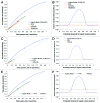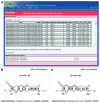MicroRNA binding sites in C. elegans 3' UTRs
- PMID: 24827614
- PMCID: PMC4156501
- DOI: 10.4161/rna.28868
MicroRNA binding sites in C. elegans 3' UTRs
Abstract
MicroRNAs (miRNAs) are post-transcriptional regulators of gene expression. Since the discovery of lin-4, the founding member of the miRNA family, over 360 miRNAs have been identified for Caenorhabditis elegans (C. elegans). Prediction and validation of targets are essential for elucidation of regulatory functions of these miRNAs. For C. elegans, crosslinking immunoprecipitation (CLIP) has been successfully performed for the identification of target mRNA sequences bound by Argonaute protein ALG-1. In addition, reliable annotation of the 3' untranslated regions (3' UTRs) as well as developmental stage-specific expression profiles for both miRNAs and 3' UTR isoforms are available. By utilizing these data, we developed statistical models and bioinformatics tools for both transcriptome-scale and developmental stage-specific predictions of miRNA binding sites in C. elegans 3' UTRs. In performance evaluation via cross validation on the ALG-1 CLIP data, the models were found to offer major improvements over established algorithms for predicting both seed sites and seedless sites. In particular, our top-ranked predictions have a substantially higher true positive rate, suggesting a much higher likelihood of positive experimental validation. A gene ontology analysis of stage-specific predictions suggests that miRNAs are involved in dynamic regulation of biological functions during C. elegans development. In particular, miRNAs preferentially target genes related to development, cell cycle, trafficking, and cell signaling processes. A database for both transcriptome-scale and stage-specific predictions and software for implementing the prediction models are available through the Sfold web server at http://sfold.wadsworth.org.
Keywords: GO analysis; developmental stage; microRNA; prediction; target binding site.
Figures




Similar articles
-
STarMirDB: A database of microRNA binding sites.RNA Biol. 2016 Jun 2;13(6):554-60. doi: 10.1080/15476286.2016.1182279. RNA Biol. 2016. PMID: 27144897 Free PMC article.
-
CLIP-based prediction of mammalian microRNA binding sites.Nucleic Acids Res. 2013 Aug;41(14):e138. doi: 10.1093/nar/gkt435. Epub 2013 May 22. Nucleic Acids Res. 2013. PMID: 23703212 Free PMC article.
-
Analysis of microRNA-target interactions by a target structure based hybridization model.Pac Symp Biocomput. 2008:64-74. Pac Symp Biocomput. 2008. PMID: 18232104
-
Desperately seeking microRNA targets.Nat Struct Mol Biol. 2010 Oct;17(10):1169-74. doi: 10.1038/nsmb.1921. Nat Struct Mol Biol. 2010. PMID: 20924405 Review.
-
MicroRNA Target Recognition: Insights from Transcriptome-Wide Non-Canonical Interactions.Mol Cells. 2016 May 31;39(5):375-81. doi: 10.14348/molcells.2016.0013. Epub 2016 Apr 27. Mol Cells. 2016. PMID: 27117456 Free PMC article. Review.
Cited by
-
STarMirDB: A database of microRNA binding sites.RNA Biol. 2016 Jun 2;13(6):554-60. doi: 10.1080/15476286.2016.1182279. RNA Biol. 2016. PMID: 27144897 Free PMC article.
-
Characterization of the mammalian miRNA turnover landscape.Nucleic Acids Res. 2015 Feb 27;43(4):2326-41. doi: 10.1093/nar/gkv057. Epub 2015 Feb 4. Nucleic Acids Res. 2015. PMID: 25653157 Free PMC article.
-
Astaxanthin Induces Transcriptomic Responses Associated with Lifespan Extension in Caenorhabditis elegans.Antioxidants (Basel). 2022 Oct 27;11(11):2115. doi: 10.3390/antiox11112115. Antioxidants (Basel). 2022. PMID: 36358487 Free PMC article.
-
STarMir: a web server for prediction of microRNA binding sites.Nucleic Acids Res. 2014 Jul;42(Web Server issue):W114-8. doi: 10.1093/nar/gku376. Epub 2014 May 6. Nucleic Acids Res. 2014. PMID: 24803672 Free PMC article.
-
STarMir Tools for Prediction of microRNA Binding Sites.Methods Mol Biol. 2016;1490:73-82. doi: 10.1007/978-1-4939-6433-8_6. Methods Mol Biol. 2016. PMID: 27665594 Free PMC article.
References
Publication types
MeSH terms
Substances
Grants and funding
LinkOut - more resources
Full Text Sources
Other Literature Sources
